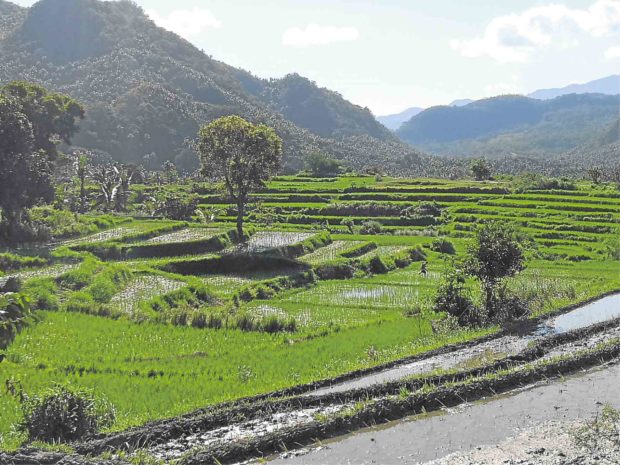
The rice terraces of Jaybanga sustain a community in Lobo, Batangas, and provide tourists an alternative ecotourism destination. —CLIFFORD NUÑEZ
LOBO, Batangas — This coastal town has been known for its long, fine beaches and challenging hiking trails, but tucked in its territory is an unusual site that has been steadily attracting tourists.
The Jaybanga rice terraces are stacked in 30 hectares of land in the upland village of Jaybanga, situated in the southwest coast of this third-class municipality (annual income: P35 million-P45 million).
Although with shorter steps—each layer is about 1.22 meters (4 feet) high — and far less expansive than the famed terraces of Ifugao province, Jaybanga’s unspoiled beauty is definitely worth a peek.
“As we say, why travel far north when you can see it here [in Batangas]?” asked Jervy Dimaano of the municipal agriculture office.
Mountain, coastal views
About 148 kilometers from Manila, Lobo is bordered by Batangas City to the west, the town of San Juan to the east, Taysan and Rosario towns to the north, and the marine biodiversity-rich Verde Island Passage to the south.
To reach it, visitors could choose between the “mountain view” route via Ibaan town and the “coastal view” route via Barangay Libjo, Batangas City, municipal tourism officer Lota Manalo said. The coastal view route takes 15 minutes longer to negotiate.
From the town center, it takes about 45 minutes to reach Barangay Jaybanga, 143 meters above sea level (masl).
There is no regular public transportation to Jaybanga (population: 1,652 as of 2016), except for a single jeepney that leaves every morning (fare: P60). Most residents own motorcycles.
The road up the village is concrete, though some portions are quite steep. A brief river crossing through the shallow Ilog Lobo adds a little excitement to the trip.
“It’s like a valley,” said Dimaano, pointing at the vast mountain range that surrounds the Jaybanga rice terraces.
Lobo has five mountain peaks, the highest and most popular of which is Mt. Naguiling at 1,007 masl. At the foot of Naguiling is a dam built by farmers to supply water to the rice terraces.
The Jaybanga rice terraces was built in the early 1990s, way younger compared with those in the Cordilleras.
Forty-seven families, among them the Abdons, own and cultivate the fields.
“It was built by hand and with an ‘araro’ (plow). It was built this way because of the topography and the natural flow of water from the mountains,” said Xyrex Abdon, a farmer.
Xyrex, 30, is one of the leaders of Jaybanga farmers. In 2015, the Batangas agriculture office recognized him as a farmer-scientist.
His father, Supremo, is one of the old farmers in the village who built the terraces.
“The rice we grow here is supplied to the town center,” Xyrex said.
The Abdons own 8.2 ha of land that produces about 40 sacks of rice per season. They grow high-yielding varieties although they were recently trying to grow varieties of brown rice, too.
“They also started vermicomposting here using the African nightcrawlers,” Dimaano said.
In June 2015, the Jaybanga rice terraces was recognized as one of Calabarzon (Cavite, Laguna, Batangas, Rizal and Quezon) region’s ecotourism sites by the Department of Tourism and the Department of Environment and Natural Resources.
Tourists have since begun visiting the village, said Xyrex’s mother, Eddielyn.
“Some (tourists) would stay at my little sari-sari (variety) store and would ask me to prepare their lunch,” she said.
Up in Jaybanga, male farmers are also engaged in catching “labuyo (wild fowl)” from the forests. If they are lucky enough to catch one during your visit, they could prepare them for lunch.
The municipal tourism office said about 130,000 visitors—mostly beachgoers and hikers—visit Lobo each year. The town targets one million tourist arrivals by 2022, with the Jaybanga rice terraces as a must-see destination.